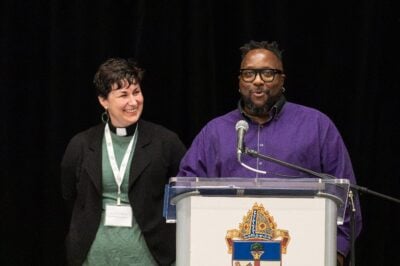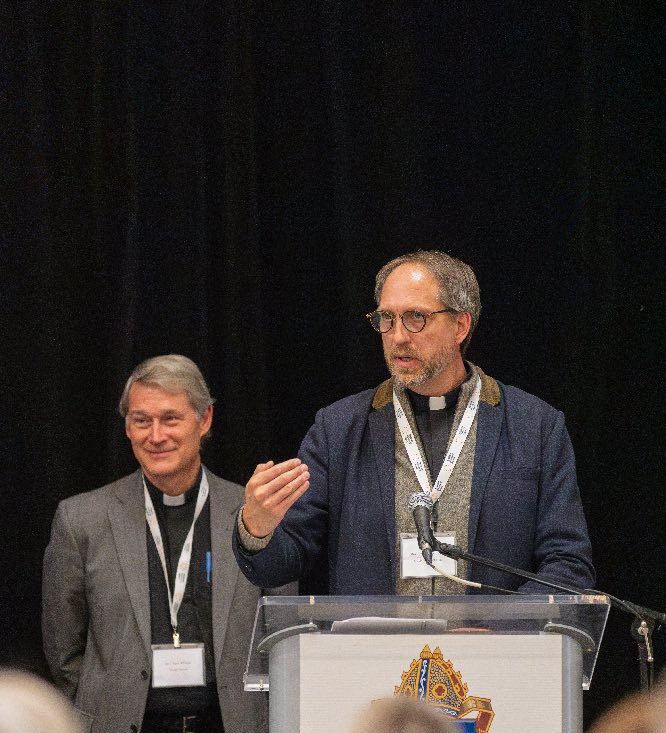At Synod 2022, there was a palpable excitement and energy in discussions about finding new ways for the church to engage with the world around it. At this year’s Synod, a team unveiled an Action Plan for Contextual Mission and New Worshipping Communities.
What is contextual mission?
Archdeacon Mark Whittall explained that contextual mission begins with the question “How is God calling us to proclaim the Good News in our time and our place?…We live in a post-pandemic, what some people call a post-Christendom world.” But he underlined that the church still has gifts and a life-giving faith to offer others. “We have wonderful communities of faith that can welcome those who are looking for a spiritual home. The connection, the joy, the sense of belonging that we offer is of incredible value. Our Anglican tradition, at its best, is thoughtful and generous. Our liturgies are participatory and beautiful. We are grounded in compassion and committed to social justice. We are a global communion. We are rooted in the apostolic tradition. We have demonstrated a capacity to evolve in our thinking and practices and to engage with contemporary issues. We certainly aren’t perfect, but we have shown at least some capacity to acknowledge our mistakes and to repent. We offer a spiritual home where people can deepen their connection with God and with each other, where we can grow, where we can care for one another, and serve our neighbours.”
Contextual Mission at St. James, Perth
The Rev. Thomas Brauer offered an example to illustrate what contextual mission is from the experience of St. James, Perth when kids broke into the church basement with their skateboards. The church’s initial reaction was to put up “No skateboarding” signs, but when challenged by a young parishioner named Peter, it changed course and instead added skateboarding ramps to welcome and embrace that community of young people. Brauer recounted that later one of the mission leaders said that “One of the goals we have here is getting better at skateboarding, as well as fellowship and praising God.”
Even though that ministry to the skaters no longer operates, Brauer said “its success is found in the fact that the church had the courage to go where God sent them, to the place the community needed them, and to partner in God’s mission for the time it was needed.” Not every effort in contextual mission will lead to an opportunity to create a new worshipping community, but those efforts offer opportunities to engage, build relationships, and to explore the potential for new worshipping communities.
“The Spirit beckons”
Paul Mugarura, who leads a new worshipping community on Sunday afternoons at Trinity Church in Ottawa, spoke at last year’s Synod about the need for parishes to be more welcoming and open to Anglicans and Christians coming to Canada from other parts of the world. This year, he offered inspiration for parishes exploring the possibilities for contextual mission and new worshipping communities.

“I believe that the reason that the Anglican Church has persisted for so long and did not die off after a generation was because those who were stewards of the movement before us met the challenges of their contexts head-on. What is different, however, is that we’re living through an unprecedented season of accelerated demographic, cultural, societal, and religious change. And so the pace of our response has to be changed. Our capacity to respond has to be increased. Our imagination has to be activated. Our willingness to try new things has to be encouraged. … As our demographics change, we will have to navigate the tension between stewarding our legacy and imagining a new Anglican tradition or movement that thrives in the future. As the ethnicities in our communities change, we will have to make room for expressions of faith that may differ from our historical expressions.
The rapidly changing context in which we currently live may look daunting to some, but I’ve come to see things differently…. I believe that this is an opportunity to add new pages to the book….. I believe that we can build on the work of legacy congregations by starting new faith communities which are not viewed as competition because they’re reaching new people. I believe that we can be agents of justice in a world beset by injustice. I believe that we can be instruments of grace and peace in a world of deep division and suspicion. I believe that the work the church has to do is not yet complete. Our changing context illuminates new, exciting roads to travel. I believe the spirit beckons.”
What is a new worshipping community?
The Rev. Thomas Brauer tackled this question. “By new community, we mean a community that is centred on Jesus Christ. That’s not new. That’s what we’ve all been doing all this time. That may be born out of our inherited congregations, again, that’s not the new part, or out of our outreach programs and other activities, but especially are born out of the unique prompting of God. And sometimes that is more new than we would like it to be. Not born out of a strategic action plan but born out of the prompting and movement of God discerned through prayer and attention to the Spirit of God.
“By worshipping community, we mean that it is a community that nourishes and practices discipleship in Jesus Christ (again, that’s nothing new. That’s what we are. It’s our DNA.) and has the capacity to evolve into a community of Word, Sacrament and pastoral care.” He was quick to add, however, that it doesn’t need to start there. “A new worshipping community does not need to be a community of… the Eucharist. It can be something radically different, but if it has the capacity to move into that, then we understand it to be the potential of a new worshipping community.”
What would a new worshipping community look and be like?
“It may be a new church plant, perhaps, spot into our Anglican heritage and tradition, because that’s what the people are needing,” said Brauer. “Or it could be something else, new, and noticeably different from what we might expect of inherited Sunday morning-style expressions of worship and community.”
He offered St. Jimmy’s Table in Carleton Place, which has been identified as one of two new worshipping community pilot projects, as an example. At St. Jimmy’s Table, they have monthly events for families with crafts and other activities, with a meal and child-friendly faith formation. “It is in every way church, but it’s not in the church. And in fact, it is intended for those families and people for whom Sunday morning worship isn’t working. They can’t get there. It’s not fitting,” Brauer said. But it is an evolving worshipping community that is adding a youth component. “Now it is truly multi-generational, whole families, parents, children, teenagers. And they can tailor their work for the unique needs of the different ages within that group.
“We would call St. Jimmy’s Table the new worshipping community because it is a new expression of worship, meeting the needs of a community that might not already have a church home, while also welcoming those who are already part of the church, but have a different set of needs. They are nourishing and practicing discipleship in Jesus Christ across multiple generations, and it has the capacity to grow.”
The Vision
Bishop Shane outlined how this new forward-looking initiative will involve every parish:
“By 2028, each one of our parishes and congregations will be engaged in contextual mission, and each one will have initiated or collaborated in at least one identifiable new venture. By 2032, the 135th anniversary of the founding of our diocese, we will have 35 new worshipping communities in a great variety of shapes and sizes. Resources to support the formation of lay and clergy leaders in contextual mission and the creation of new worshipping communities will be shaped by the new contextual mission subcommittee. A microgrants program to support new initiatives will also be rolled out.
Today, we are launching the essential foundation of our vision and goals. As I now call our diocesan church into a time of prayer as we listen for the divine sparks in our midst.
How will the people and parishes of the diocese do this?
The Rev. Simone Hurkmans was the team member tasked with explaining how this ambitious vision could be realized.
She unveiled an action plan with 27 concrete actions, divided into five broad categories: A time of prayer; establishing and overseeing the practice of contextual mission; supporting leaders, lay and clergy; supporting parishes and congregations, and financial resources.
“The important thing to note is that all of the actions share a common theme and that word that describes that theme is support,” Hurkmans said. “The actions are all about supporting us in doing God’s work in the world.”
The first and essential step is prayer, she said. “We can look at demographics, we can look at statistics, we can look at business plans. But over the past year, our research in talking to people who have done contextual ministry, who have started new worshipping communities, is that it has to be rooted in prayer.”
After Synod approved the Action Plan, A Time of Prayer was officially launched on the final morning of Synod with a prayer asking the Holy Spirit to help all of the parishes in the diocese discover God’s divine sparks in their midst.
The Action Plan
- A Time of Prayer – Listening for Divine Sparks in our Midst This diocesan-wide initiative was launched on the final morning of Synod. It calls on all parishes, groups, and individuals to participate in regular prayer to discern where God wants parishes and congregations to act. The bishop will appoint a working group to pray for, oversee, and implement “A Time of Prayer.” Each parish and group will identify a point person. Prompts, resources, and prayers will be generated.
- Establishing and overseeing the practice of Contextual Mission – The bishop, Diocesan Council and other lay and clergy leaders will play an essential role in the support, monitoring, evaluation, and communications.
- Supporting Leaders, Lay and Clergy – with resources such as a knowledge network, qualified coaches, symposia, opportunities to participate in courses and workshops
- Supporting Parishes and Congregations– with a step-by-step guide to engaging in contextual mission and new worshipping communities; multiple sources of funding and other resources
- Financial Resources – Parish funds used to support new contextual mission initiatives and NWCs will be exempt from assessment for Proportional Parish Share and a microgrant program will be established to support contextual mission and NWCs and will be financed from the Future Fund.
Finances
Presented by Sandra Hamway, ADO director of communications and development, Synod approved a proposal first discussed at the 2022 Synod to rename and repurpose the existing Second Century Fund as the Future Fund to provide resources for contextual mission and new worshipping communities.
The fund (currently about $1.6 million) will essentially function as an endowment, maintaining its principal while offering about $62,000 in dividends each year for use as microgrants, with some possibility for draw downs on the principal, which will not fall below $1 million. The fund will be overseen by a panel and the bishop.
The Action 2 team thanked Karen McBride, a student at St. Paul University, who was instrumental in helping craft a Time of Prayer and will be putting together the resources for parishes such as Prayers of the People and Bible studies.


St. James, Morrisburg — Stormont Deanery